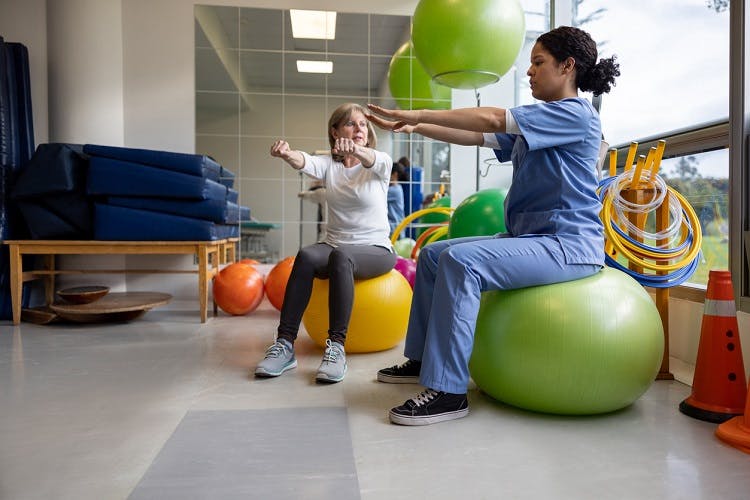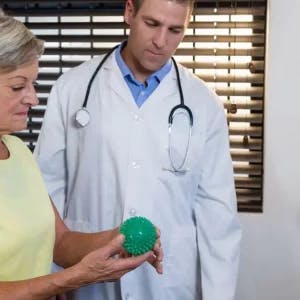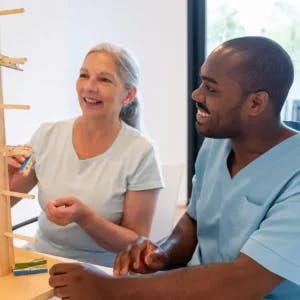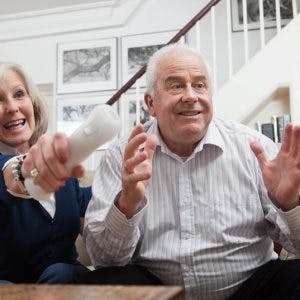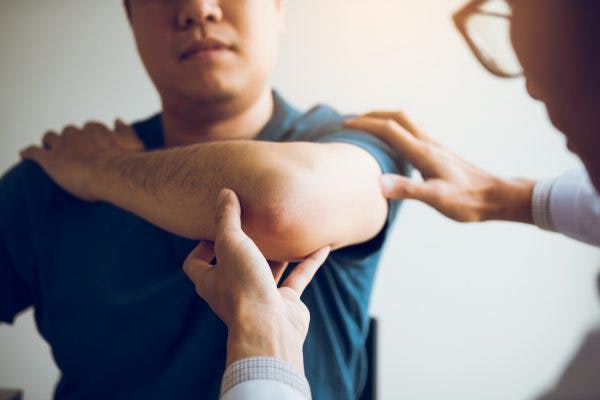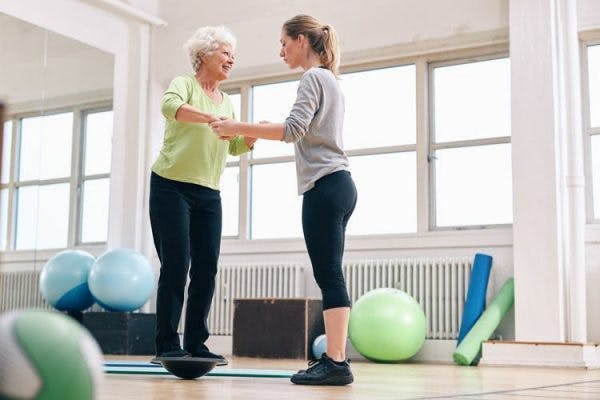After a stroke, individuals may struggle to perform the activities of daily living such as eating, bathing, or getting dressed. Fortunately, occupational therapists are specifically trained to help individuals find ways to effectively complete these tasks, among others.
Occupational therapy gets its name from its focus on empowering individuals to independently engage in their occupations, or the activities that “occupy” their time. Different stroke interventions used in occupational therapy can help individuals maximize their functional independence and navigate changes in life after stroke.
This can include learning recovery exercises and compensation strategies to promote participation in valued daily activities. This article will discuss various stroke interventions used in occupational therapy and how they help promote recovery.
Understanding the Goals of Occupational Therapy During Stroke Rehabilitation
Occupational therapy focuses on providing individuals with the proper skills and tools necessary to achieve their recovery goals. They do so by using a combination of rehabilitation exercises and compensatory tactics.
Compensation involves accomplishing a task in a different way than before, whereas rehabilitation involves accomplishing a task in the same way as before the stroke. For example, after a stroke individuals may struggle with foot drop, or the inability to lift the front portion of the foot. As a result, the toes may drag on the floor, increasing the risk of a trip or fall.
To help compensate for the muscle weakness associated with foot drop, a therapist may recommend wearing ankle foot orthotics. Using an AFO brace is a compensatory tactic that can help provide support to the foot and ankle and lower the risk of further injury. However, an AFO brace does not treat the root cause of foot drop, which is the miscommunication between the brain and muscles. To treat the root cause and improve foot drop, survivors must practice foot drop recovery exercises.
Occupational therapists focus on addressing any areas that impede the survivor’s ability to accomplish activities necessary to fulfill their daily roles. This involves actively collaborating with the survivor to find out what activities are most important to them to establish therapy goals.
After identifying which activities the survivor would like to address, occupational therapists can provide personalized exercises that target specific muscle groups such as the arms, legs, and trunk, tailored to the individual’s ability level. They can also provide specific tasks to help survivors improve their independence and achieve their recovery goals.
Activities that survivors want to focus on during occupational therapy usually fall into three categories, including:
- Self-care: personal daily activities, including eating, bathing, and getting dressed, in addition to household management tasks such as cooking and cleaning.
- Productivity: tasks can consist of returning to work, school, or other prior responsibilities and finding new ways to adjust.
- Leisure: activities usually include fun things a person enjoyed doing prior to the injury such as golfing, painting, dancing, and other social skills.
Self-care, productivity, and leisure activities are an important part of everyday life. The more these skills are practiced, the higher the chances of regaining function and seeing promising results.
15 Occupational Therapy Interventions for Stroke Survivors
There are various interventions occupational therapists can use with their clients, including exercises to improve fine motor skills or fun activities to help them ease back into life after a stroke.
Some occupational therapy interventions for stroke recovery can include:
1. Home Modifications
After discharge, it can be challenging to transition smoothly back home. An occupational therapist can help make the appropriate adjustments to ensure an individual’s safety. This can include making home modifications such as adding doorknob extenders and/or using non-slip bathmats.
A therapist may also suggest removing rugs and excess clutter from the floor to lower the risk of falling. A smoother transition can help survivors feel more at ease and redirect their energy towards healing.
2. Rehabilitation Exercise Programs
An occupational therapist can provide various targeted exercises for individuals to practice safely at home. Establishing a proper rehabilitation program at home and practicing therapeutic exercises consistently is important to stimulate neuroplasticity, the brain’s ability to rewire itself. It works by strengthening neural connections in the brain and creating new ones, which is an essential part of stroke recovery.
3. Interactive Neurorehab Devices
An occupational therapist may provide a written home exercise program for clients to practice at home in between therapy sessions. However, in order to keep survivors more engaged, they may also recommend using interactive at-home therapy programs like FitMi and MusicGlove. Both were designed to improve mobility and can help survivors increase their chances of regaining function after a stroke. There are also clinic versions of these neurorehab devices available for occupational therapists to use with their clients in a clinical setting.
4. Task-Specific Training
Task-specific training is a stroke intervention that focuses on improving a skill by practicing it directly. The goal is to improve function in the affected muscle(s) through repeated activity. Task-specific training may include activities such as reaching into a cupboard, turning door knobs or flipping light switches on and off. Practicing these exercises can spark neuroplasticity in the brain and help improve functional independence.
5. Visual Scanning
Spatial neglect is a condition that can make it difficult to orient, identify, or respond to stimuli in the environment on the affected side. For instance, when an individual sustains a stroke in the right hemisphere of the brain, they can experience spatial neglect on their left side.
Fortunately, visual scanning can help treat spatial neglect by encouraging individuals to intentionally draw their attention to their affected side. For example, one visual scanning activity an occupational therapist may suggest is using a highlighter to draw a bright line down the left side of a book. The individual must then practice moving their eyes all the way to the left until they find the highlighter mark.
6. Constraint Induced Movement Therapy
Constraint induced movement therapy (CIMT) is a stroke intervention that involves restraining the non-affected limb in order to promote use of the affected limb. The goal is to increase the use of the affected limbs to stimulate the brain and activate neuroplasticity. While CIMT is frequently practiced on the arms, it can also be used to increase use of an affected leg. To practice CIMT at home, an occupational therapist may suggest wearing an oven mitt or a sock over the non-affected limb to help encourage the survivor to use their affected limb.
While this treatment approach may be challenging, it can help lower the risk of learned non-use after a stroke, which occurs when an individual becomes so used to not using their affected limb that they end up suppressing its use. If learned non-use persists, it can lead to further complications such as muscle weakness and muscle atrophy in the affected limb. Occupational therapists can provide more tips on how to prevent learned non-use from occurring or worsening.
7. Electrical Stimulation
When the areas of the brain that control movement are affected by a stroke, the brain may be unable to communicate effectively with certain muscles. Without the appropriate stimuli from the brain, the muscles don’t know when to contract or relax. This can result in motor difficulties like paralysis, weakness, or spasticity (stiff, rigid muscles). This can make it difficult to move or perform daily activities.
Fortunately, studies show that electrical stimulation can help improve mobility and reduce spasticity in stroke survivors. It works by placing non-invasive electrodes on the skin and sending gentle electrical impulses to the affected muscles. Reactivating the muscles can help stimulate the connection between the brain and muscles, encouraging neuroplasticity.
8. Mirror Therapy
Mirror therapy is another type of stroke intervention that is particularly helpful for survivors with hand paralysis or severe hand impairments. It works by placing a tabletop mirror in the middle of the body to reflect the non-affected side and hide the affected side. Completing simple exercises with the non-affected side while focusing on the image in the mirror, which appears to be the affected side, can help survivors visualize their affected side moving typically. This stimulates the parts of the brain associated with movement, romoteng neuroplasticity.
Studies have shown that mirror therapy may help improve movement, sensation, and post-stroke pain. Another benefit from mirror therapy is that it can be performed with an occupational therapist in a clinical setting or at home independently.
9. Mental Practice
When a movement is mentally rehearsed, it can spark changes in the brain in a similar way as physically practicing movements. Because of this, mental practice is a great occupational therapy intervention for stroke survivors. For example, a survivor with limited mobility or paralysis in their right arm can picture themselves moving their arm through daily activities such as grasping a cup of coffee.
This mental exercise can help spark neuroplasticity in the brain and strengthen the neural connections for that movement, eventually making it easier to physically execute. Thus, motor imagery can be a powerful tool during rehabilitation when combined with other stroke interventions like task-specific training. An occupational therapist can also recommend tips on how to incorporate motor imagery throughout rehabilitation.
10. Activities of Daily Living Training
Occupational therapists are specialists in the area of performing activities of daily living (personal care tasks) after stroke. Since activities of daily living require physical and cognitive skills, both of which may be affected by a stroke, many survivors find that they have difficulties with these seemingly simple tasks.
Survivors may therefore practice completing their activities of daily living during occupational therapy. This gives therapists the opportunity to see where survivors are struggling in order to address safety concerns and recommend adaptive strategies. For example, occupational therapists may introduce specific dressing techniques for survivors with hemiplegia, such as always dressing the affected side first, and undressing it last.
11. Adaptive Equipment Recommendations and Education
In addition to using specific adaptive strategies to increase safety and independence with activities of daily living, occupational therapists will frequently recommend adaptive equipment. This may include devices such as a sock aide, reacher, or long-handled sponge, all of which can be used to help survivors complete their daily living tasks safely and effectively.
Furthermore, some survivors may benefit from using durable medical equipment, such as a raised toilet seat or tub bench. Occupational therapists are able to assess which types of equipment are most appropriate for an individual’s situation, and teach them how to use these devices properly.
12. Sensory Re-education
As many survivors experience sensation deficits such as numbness, a common occupational therapy intervention for stroke survivors is sensory re-education. This involves retraining the brain to appropriately process and respond to different sensations, including various textures, temperatures, and pain.
Occupational therapists may use a variety of activities designed to stimulate the sense of touch, such as feeling objects of different textures or attempting to identify common objects only through touch. Safety strategies may also be discussed, such as reducing the maximum hot water heater temperature or wearing cut-resistant gloves while chopping foods.
13. Cognitive Training and Adaptation
When the cognitive effects of stroke affect a survivor’s ability to complete their daily tasks, occupational therapy may involve cognitive training exercises and adaptive techniques. Cognitive training may include rote exercises or more engaging activities.
For example, simple card games such Uno or Concentration may be used during occupational therapy to improve attention, sequencing, and problem-solving skills. Survivors also often benefit from learning strategies to adapt to their cognitive challenges, such as frequently writing down reminders, using checklists, or minimizing distractions.
14. Fine Motor Activities
Fine motor activities are among the most common occupational therapy interventions for stroke survivors. Fine motor skills are often affected by stroke, making it challenging to complete daily tasks such as writing, typing, completing fasteners, and using silverware. Occupational therapists may use a combination of fine motor coordination and strengthening activities. This may include tasks such as picking up and manipulating small objects, using a hand therapy ball, or molding Theraputty.
15. Work Accommodations
Lastly, occupational therapy can help survivors relearn the skills they need to return to their occupation. Therapists may provide individuals with unique tasks to practice depending on the type of workload and environment.
To transition smoothly back to work after a stroke, OTs may also recommend:
- Working shorter hours
- Taking breaks to help prevent overstimulation
- Installing grab bars in the office restrooms to help with balance
- Having ergonomic equipment and flexible scheduling to help with increased fatigue after a stroke
- Working “smarter, not harder” through task simplification (if possible)
- Practicing proper body mechanics (how one moves) to reduce muscle strain
- Using wall calendars and alternative lighting to help with concentration and spatial neglect
Therapists may also encourage their clients to talk to their employer about what they can do to help facilitate their return to work. It’s important to note that the Americans with Disabilities Act requires employers to make reasonable accommodations for their employees to help them get back to work.
Occupational Therapy Interventions for Stroke Recovery
A stroke can interfere with the ability to perform the activities of daily living and maintain a proper rehabilitation regimen. Fortunately, there are various stroke interventions used in occupational therapy that can help survivors reach their recovery goals and maximize functional independence.
We hope this article helped you understand the benefits of various stroke interventions used in occupational therapy.

